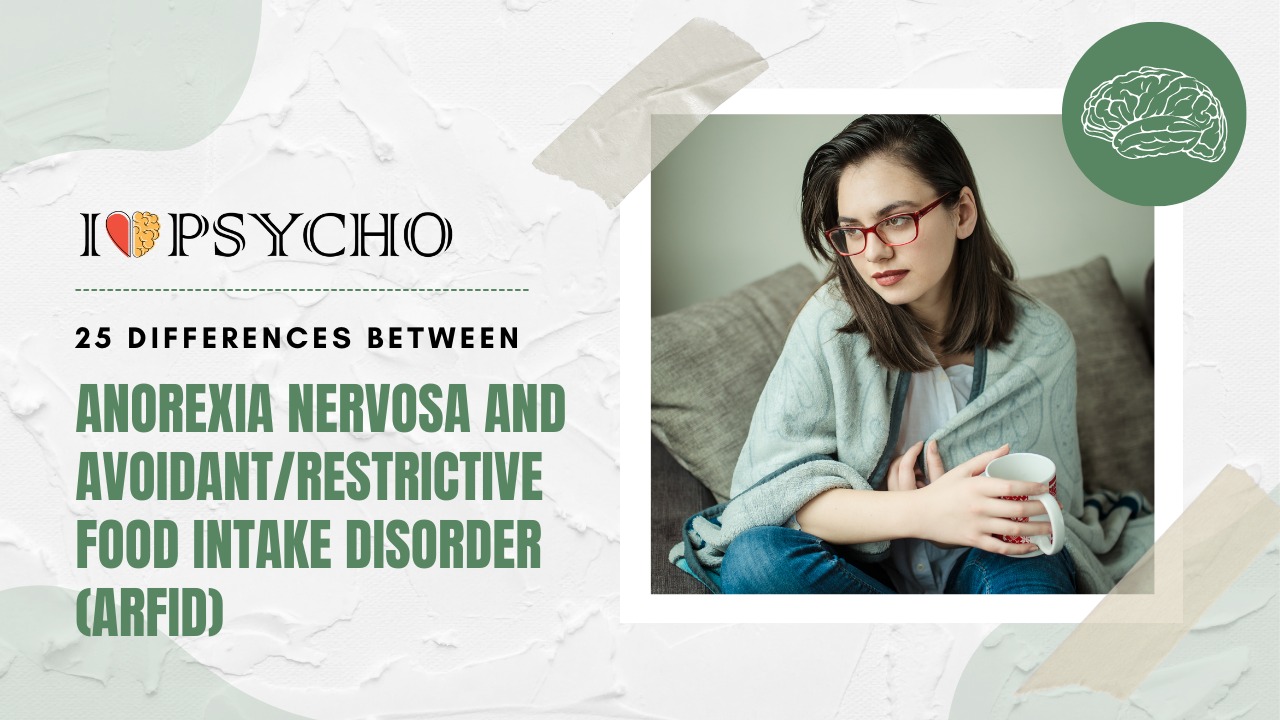The symptoms, causes, and treatments of Anorexia Nervosa and Avoidant/Restrictive Food Intake Disorder (ARFID) are different. Due to a distorted body image and a fear of gaining weight, people with anorexia Nervosa drastically restrict their food intake and engage in significant weight loss. Anorexics may overexercise and starve themselves while being underweight. In contrast, ARFID involves an aversion to particular foods, textures, colors, or odors, which might restrict dietary diversity and nutrient intake. People with ARFID may have physical pain when eating but not body image concerns like anorexia.
These illnesses have different causes. However, sensory sensitivities, unpleasant food experiences, and developmental variables including childhood trauma or autism spectrum disorders are usually linked to ARFID. Due to symptomatology differences, diagnosis differs. Low body weight, acute dread of weight growth, and distorted body image define anorexia. However, sensory aversions hinder eating, causing malnutrition and reduced functioning in ARFID.
Treatments vary greatly. Anorexia treatment includes medical stabilization, dietary rehabilitation, counseling, and medication. Behavioral therapies like CBT and FBT are prevalent. Sensory desensitization, incremental exposure to avoided foods, and a multidisciplinary approach comprising nutritionists, therapists, and occupational therapists treat ARFID. However, ARFID is based on sensory sensitivities or prior unpleasant experiences and restricts food, texture, and smell aversions. Both illnesses restrict diet, but their origins, diagnostic criteria, and treatments differ. Understanding these distinctions is essential for diagnosing and treating eating problems.
Also Read: 47 Difference between Anorexia Nervosa and Bulimia Nervosa
Here are 25 differences between Anorexia Nervosa and Avoidant/Restrictive Food Intake Disorder (ARFID):
|
S.No. |
Aspects |
Anorexia Nervosa |
Avoidant/Restrictive Food Intake Disorder (ARFID) |
|
1 |
Definition |
Anorexia Nervosa is characterized by the intense fear of gaining weight or becoming fat, leading to restricted food intake, a distorted body image, and significant weight loss. |
ARFID is characterized by a limited variety of food preferences or avoidance of certain foods due to sensory issues, aversions, or fear of negative consequences (e.g., choking). |
|
2 |
Fear of Weight Gain |
Anorexia is primarily driven by the fear of weight gain and a desire to be thin. |
ARFID is not motivated by a fear of weight gain but rather by sensory sensitivities, food aversions, or concerns about the consequences of eating certain foods. |
|
3 |
Body Image Distortion |
Anorexia often involves a distorted body image, where individuals perceive themselves as overweight despite being underweight. |
ARFID does not necessarily involve a distorted body image; it is primarily about food aversions and sensory sensitivities. |
|
4 |
Weight Loss |
Significant weight loss is a common characteristic of anorexia nervosa. |
Weight loss is not a defining feature of ARFID; individuals may have normal weight or be underweight, but it’s not a primary goal. |
|
5 |
Preoccupation with Thinness |
Anorexia is often associated with a preoccupation with thinness and a desire to achieve a specific body shape or size. |
ARFID is not concerned with body shape or size; it is more focused on food avoidance and sensory issues. |
|
6 |
Calorie Counting |
People with anorexia may obsessively count calories and restrict their food intake to a minimal level. |
Calorie counting is not a characteristic of ARFID; avoidance of certain foods is typically unrelated to calorie content. |
|
7 |
Medical Complications |
Anorexia can lead to severe medical complications like malnutrition, electrolyte imbalances, and damage to organs. |
ARFID is less likely to result in severe medical complications because it is primarily about food avoidance rather than extreme caloric restriction. |
|
8 |
Psychological Symptoms |
Anorexia is associated with psychological symptoms such as intense anxiety, depression, and obsessive thoughts about food and body weight. |
ARFID may lead to anxiety related to food and eating but is not typically accompanied by body image distortions or obsessive thoughts about weight. |
|
9 |
Refusal to Maintain Body Weight |
Anorexia involves a refusal to maintain body weight at or above a minimally normal level for age and height. |
ARFID does not necessarily involve a refusal to maintain body weight; individuals may maintain a normal weight or have fluctuations. |
|
10 |
Emotional Regulation |
Anorexia may involve using food restriction as a way to cope with emotional distress and gain a sense of control. |
ARFID is primarily related to sensory sensitivities and aversions rather than emotional regulation. |
|
11 |
Food Groups Avoided |
In anorexia, there may be a broader range of food groups avoided, with a focus on reducing overall caloric intake. |
In ARFID, specific foods or textures are avoided, often unrelated to caloric content. |
|
12 |
Eating Rituals |
Anorexia may involve specific eating rituals, such as cutting food into tiny pieces or eating very slowly. |
ARFID does not necessarily involve eating rituals but may include avoidance of certain textures or food smells. |
|
13 |
Meal Skipping |
People with anorexia often skip meals or drastically reduce meal portions. |
ARFID may involve selective eating during meals rather than skipping them altogether. |
|
14 |
Secret Eating |
Anorexia may involve secretive eating behaviors, such as hiding food or eating in isolation. |
ARFID does not typically involve secretive eating; avoidance is often openly expressed. |
|
15 |
Body Mass Index (BMI) |
Anorexia often results in a BMI below the healthy range for age and height. |
ARFID may have a wide range of BMIs, including normal or even overweight. |
|
16 |
Age of Onset |
Anorexia typically begins in adolescence or young adulthood. |
ARFID may begin in childhood but can persist into adolescence and adulthood. |
|
17 |
Impact on Social Life |
Anorexia can lead to social isolation due to avoidance of social eating and a preoccupation with weight and food. |
ARFID may impact social life, particularly in situations involving specific foods or textures, but it is not primarily driven by concerns about body image or social appearance. |
|
18 |
Nutritional Deficiencies |
Anorexia often results in severe nutritional deficiencies due to inadequate food intake. |
ARFID may lead to nutritional deficiencies related to the specific foods or food groups that are avoided. |
|
19 |
Appetite |
Anorexia typically involves a reduced appetite or a loss of interest in eating. |
ARFID individuals may have a regular appetite for non-avoided foods. |
|
20 |
Psychiatric Comorbidity |
Anorexia often co-occurs with other psychiatric disorders such as depression, anxiety, or obsessive-compulsive disorder. |
ARFID may be less likely to have comorbid psychiatric disorders and is more focused on sensory issues. |
|
21 |
Treatment Approach |
The primary treatment for anorexia includes medical stabilization, nutritional rehabilitation, and psychotherapy focused on body image and eating behaviors. |
ARFID treatment often involves exposure therapy to expand the range of accepted foods and address sensory sensitivities. |
|
22 |
Fear of Vomiting |
Anorexia may involve a fear of vomiting, which contributes to food avoidance. |
ARFID may involve a fear of specific textures, smells, or tastes, rather than a fear of vomiting. |
|
23 |
Body Checking |
Individuals with anorexia often engage in body checking behaviors, such as frequent weighing or measuring body parts. |
Avoidant/Restrictive Food Intake Disorder (ARFID) individuals are less likely to engage in body checking behaviors related to weight or appearance. |
|
24 |
Focus on Body Size |
Anorexia is characterized by a strong focus on achieving a specific body size or shape, often associated with extreme thinness. |
ARFID has no focus on body size or shape; it centers on food aversions and sensory issues. |
|
25 |
Relationship with Food |
Anorexia involves a complicated relationship with food, often marked by fear, avoidance, and extreme control. |
ARFID involves a simpler relationship with food, centered on specific sensitivities and aversions, rather than fear or control related to body weight or appearance. |
Also Read: 44 Difference between Dissociative Identity Disorder (DID) and Dissociative Amnesia
Frequently Asked Questions (FAQS)
Q.1 What is Anorexia Nervosa?
A distorted body image, extreme fear of weight gain, and self-imposed dietary restriction describe anorexia Nervosa. Self-induced vomiting, severe calorie restriction, and intense exercise are common among anorexics. Therapy, medical monitoring, and dietary rehabilitation are usual treatments.
Q.2 How does ARFID differ from picky eating?
More than finicky eating, ARFID is a disorder. ARFID may avoid foods because of sensory sensitivity, food trauma, or a general lack of interest in eating, unlike fussy eaters. Avoidance can cause dietary deficits and illness. Sensory desensitization and progressive exposure to avoided foods are ARFID treatments.
Q.3 Does ARFID have body image issues?
ARFID is not body image-driven like Anorexia Nervosa. Sensory aversions can cause anxiety or discomfort while consuming particular meals in ARFID patients. In contrast, anorexics worry about their weight, form, and stature.
Q.4 Can these disorders coexist?
Some people with Anorexia Nervosa and ARFID can coexist. Anorexics may avoid particular meals owing to sensory difficulties, such as ARFID. However, the key difference between the two diseases is the motive behind food avoidance: anorexia is motivated by weight and body image issues, while sensoriality drives ARFID.
Q.5 What treatments are available for these disorders?
Medical stabilization, dietary rehabilitation, and psychotherapy are common Anorexia Nervosa treatments. Behavioral therapy and family-based therapy are widespread. In contrast, ARFID therapy gradually expands a person’s dietary choices with the help of a licensed dietitian or therapist. Sensory-based and exposure treatments are important.









